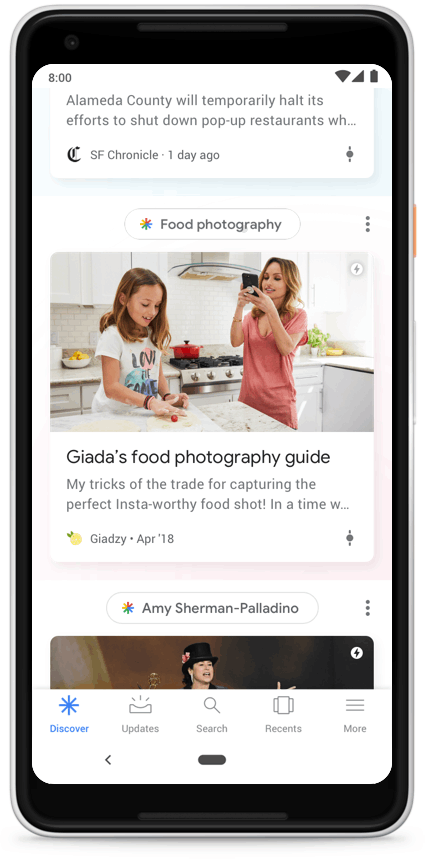In May 2019, Google Ads launched a new campaign type: Discovery Campaigns. We had the chance to test this new feature in the last few weeks. Read on to learn more about Discovery Campaigns and discover our point of view on that new feature.
What are Discovery Campaigns?
Discovery Campaigns are another one of Google’s automated campaign types running on multi-channel. The visual assets run on YouTube, Gmail, and, for the first time ever, Google Discover Feed (previously called Google Now). Google Discover’s main purpose is to help users uncover fresh and new content that matters to them. According to the search engine, more than 800 million people use the feed each month to stay up to date on their interests.
Discovery Campaigns have been compared to Facebook/Instagram Ads because they are a visually impactful, native ad format targeted based on audience data. Discovery Campaigns are targeted with audiences (interest, in-market, and affinity), not keyword-based targeting. They are also charged on a cost-per-click (CPC) basis.
Just like the other recent advertising products offered by Google, Discovery Campaigns use machine learning to deliver the best performing ads to the right users. When creating Discovery Campaigns, campaign managers can add up to 5 eye-catching headlines, 5 descriptions, and up to 15 images. As users are engaging with the ads, Google will collect data and identify the best performing combination of headlines and descriptions.
Our thoughts on Discovery Campaigns
As a digital marketing agency specializing in paid media, we LOVE trying out new betas and platform features. When we got access to Discovery Campaigns, we were thrilled to try them out and see how they could improve our accounts’ performances.
We liked the idea of Discovery Campaigns and we thought they showed a lot of promises. As users interact with the tool, it understands what type of content they like and it gives them more of it. Users are already in a discovery state of mind, they are open to new ideas, products or services. Discovery Campaigns seemed like an ideal place to target specific audiences.
The idea seemed great on paper, we just needed data to corroborate our point of view. We’ve launched Discovery Campaigns for an e-commerce fashion retailer, and in less than a month, we had very positive (and surprising!) results.
We’ve compared our traditional Google Display Campaign to Discovery Campaigns to truly assess their performance. Over the tryout period (a few weeks) Discovery Campaigns offered a better clickthrough rate, a higher conversion rate and ROAS, and a lower cost per click, than our standard display ads.
We were very pleased with our first Discovery Campaign, and we look forward to testing it on other accounts.
Who Should Use Discovery Campaigns?
In our opinion, Discovery Campaigns would be a great fit for a wide variety of brands in different industries. We would recommend Discovery Ads for any brand who’s able to provide appealing and eye-catching visuals. E-Commerce retailers or travel and tourism businesses could benefit from Discovery Campaigns.
Brands already advertising with Google Display Ads, Google Shopping and YouTube Ads should use Discovery Campaigns as a new way of showing tangible images that tell their brand story. Plus, multi-channel placements through Discover, YouTube, and Gmail mean they’ll be reaching more people and potentially new prospects. It might even give them an edge over their competitors.
Discovery Campaigns Best Practices
If you are looking to launch your first Discovery Campaigns, follow these best practices to ensure the best results :
1. Upload High-Resolution Imagery That Tells a Story
As mentioned before, eye-catching images play a big part in the success of Discovery Campaigns. Be sure to choose high-quality images and provide these 2 formats: square and landscape. Image can’t be blurry, poorly-cropped or include any call-to-action. They can also work with your existing social assets.
2. Highlights Sales and Promotions
Presenting a special offer or promotions is sure to spark the interest of your prospects, therefore, increasing their chances of converting.
3. Choose the Right CTA
A Call-To-Action included in an image will get your Discovery Campaign disapproved. Instead, use the description and the call-to-action text field to tell your prospect what action you want them to take.
4. Focus on audiences that are more likely to convert
Google suggest custom intent, remarketing and in-market audiences to get started on Discovery Campaigns. By targeting these audiences, you’ll serve ads to users most likely interested in your product or services (which translates to a higher conversion rate!)
5. Track Metrics Accurately
We have said it before, and we will say it again: accurate tracking is essential to any advertising campaign to optimize your ads and assess its performance correctly.
Want to run ads on Google Discover, but you don’t know where to start? Let our team of paid media specialists help you.
Read it first:
Get new articles delivered to your inbox
ABOUT THE AUTHOR
Jeff Johnson
Vice-President of Paid Media @ Bloom





Share this: